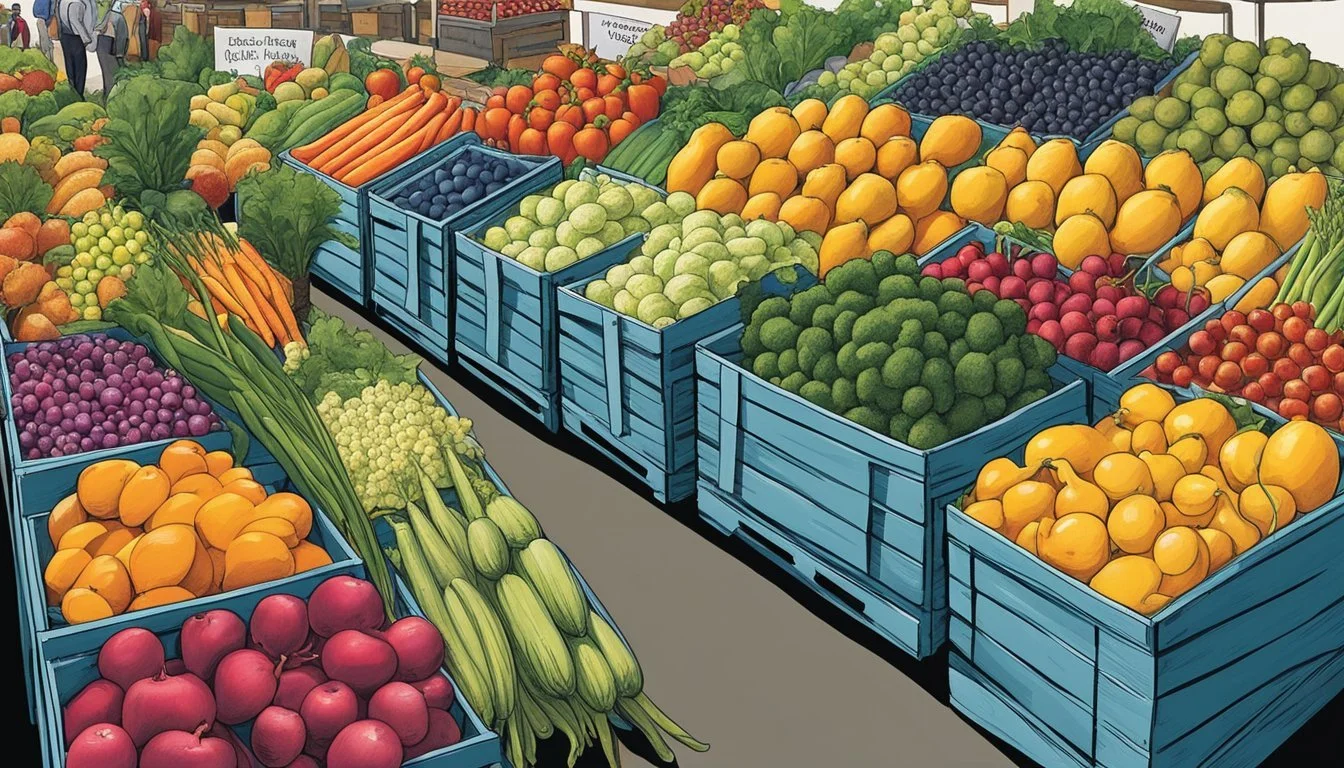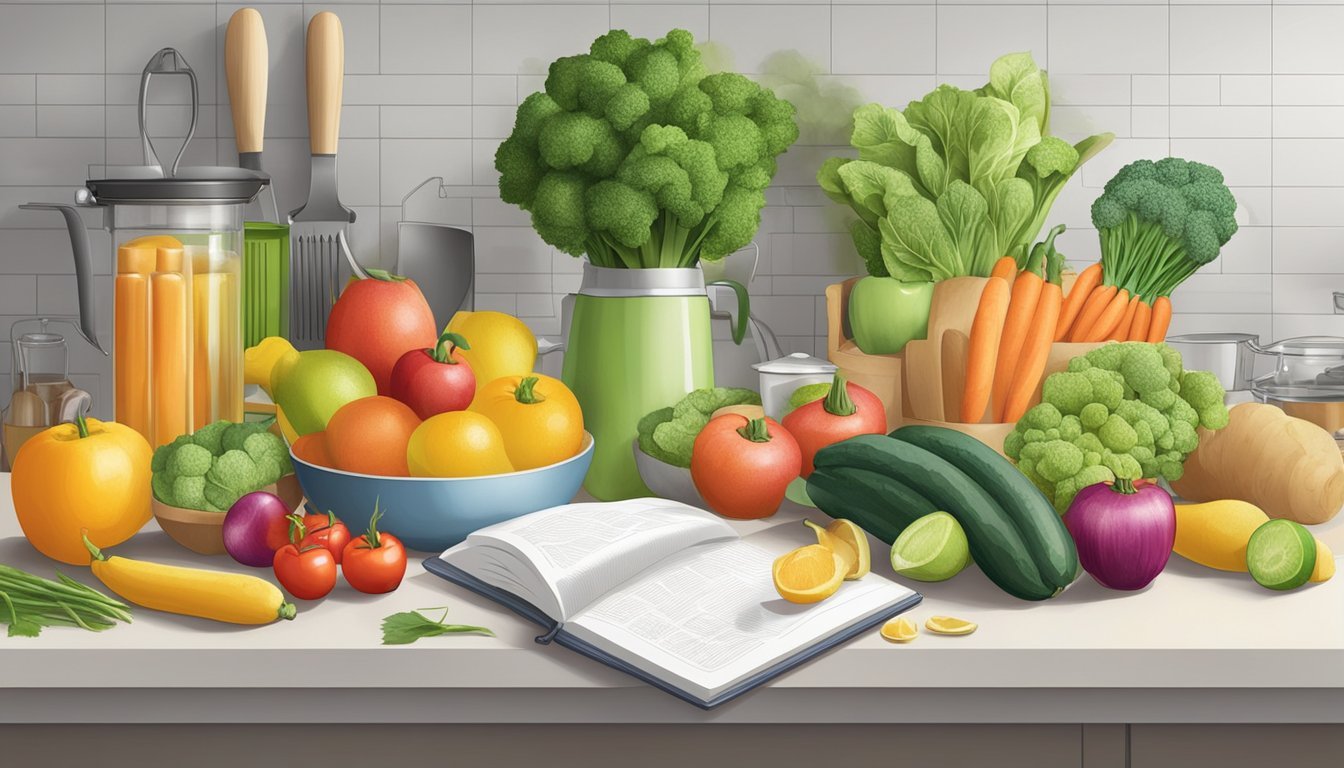Connecticut Seasonal Fruit & Vegetables in March
Your Fresh Guide
This Article is Part of our Connecticut Seasonal Fruit & Veg Calendar
As the United States welcomes the beginning of spring in March, Connecticut, a state known for its variable climate and rich agricultural history, transitions into a new season of produce. The region's seasonal shift is anticipated by both local farmers and consumers who are eager to enjoy the fresh flavors that come with the thawing of winter. While the selection of locally grown fruits (What wine goes well with fruit?) and vegetables in Connecticut during this time may not be as abundant as in the summer months, there are still several nutritious and flavorful options available.
The state's agriculture is influenced by its moderate climate, with March typically presenting the tail end of cooler weather, making it a transitional period for crop availability. Consumers seeking fresh, locally-sourced produce during this time will begin to find an increasing variety of greenhouse-grown or storage vegetables along with the first few crops that are hearty enough to withstand the cooler temperatures. They present an opportunity for residents and chefs alike to incorporate freshness into their meals while supporting the local economy.
Overview of Connecticut's Growing Season
In Connecticut, the growing season typically kicks off in the spring months, with March marking the early stages. During this time, farmers and gardeners begin planting and preparing for the months ahead. The length of the growing season in Connecticut extends into the fall, tapering off in October.
Spring (March-May)
March: Limited outdoor planting due to cooler temperatures, with some hardy vegetables like peas and spinach (What wine goes well with spinach?) being seeded.
April & May: Increased outdoor planting, including crops like lettuce, kale, and root vegetables.
Summer (June-August)
June: Warmer temperatures allow for a wide variety of fruits and vegetables to be planted and harvested.
July & August: Peak of the growing season, with fresh produce like tomatoes, peppers, and sweet corn in abundance.
Fall (September-October)
September: Continuation of summer crops with the beginning of the autumn harvest, including pumpkins and apples.
October: End of the main growing season, with some cold-tolerant crops still thriving.
Throughout these months, Connecticut experiences a variety of climate conditions that can affect the growing season, making it crucial for growers to be mindful of frost dates and to employ season-extension techniques, such as using greenhouses or cold frames, to protect sensitive crops during the unpredictable weather of early spring and late fall.
Seasonal Fruits in Connecticut for March
In March, Connecticut's fruit selections transition from late winter storage varieties to the early signs of spring. Availability is often subject to the preceding winter's conditions.
Early Spring Fruits
Connecticut welcomes the early spring with limited fruit availability. March typically does not present a wide array of fresh fruits, but they can anticipate the start of:
Horseradish (technically a plant, its roots are used as a fruit in culinary contexts)
Though not a fruit, horseradish roots are harvested during early spring and can be utilized in a variety of dishes for their pungent flavor.
Late Winter Varieties
While most trees are still dormant, storage capabilities allow consumers to enjoy fruits from the previous seasons such as:
Apples: Varieties that store well continue to be available.
Pears: Later varieties of pears can still be found in markets.
Both apples and pears should be looked for in terms of quality, as they have been in storage for several months by the time March arrives.
Seasonal Vegetables Available in March
As March arrives in Connecticut, gardeners and farmers prepare for the early spring harvest, which primarily includes hardy green vegetables, pungent alliums, and a selection of cold-tolerant root vegetables.
Spring Green Vegetables
In March, Connecticut's fields begin to yield spring green vegetables that are both nutritious and versatile.
Spinach and lettuce are among the first to appear, offering a fresh taste of spring.
Cabbage and broccoli (how long does broccoli last?), with their robust flavors, are also maturing during this period.
Root Vegetables
Despite the cold soil temperatures, certain root vegetables remain accessible in March due to their ability to be stored through winter or withstand cool temperatures.
Carrots retain their sweetness and can be harvested if the ground is thawed.
Stored potatoes are typically still available from the previous season's harvest.
Alliums
Well-known for their distinctive flavors, alliums are essential ingredients in many dishes.
Onions, cultivated the previous season, can be found in storage and offer much-needed pungency to meals.
Depending on crop planning and weather conditions, March may also see early varieties of radishes breaking through the soil.
Fresh Herbs and Other Produce
In March, gardens in Connecticut begin to offer a variety of fresh herbs (how long do fresh herbs last?) and legumes. Shoppers and gardeners can find a selection that not only enhances flavor in cooking but also contributes to a healthy diet.
Aromatic Herbs
Arugula: This leafy herb is known for its peppery taste and is excellent in salads or as a pizza topping.
Basil: Sweet basil typically starts becoming available and is a staple in pesto and Italian dishes.
Parsley: Fresh parsley varieties, used for garnishing and flavoring, start to pop up during this time.
Thyme: Preferred for its strong, earthy flavor, thyme is a versatile herb used in various culinary recipes.
Seasonal Legumes
Beans: Gardeners may begin to plant beans, which will soon offer fresh beans in a range of varieties.
Peas and Pea Pods: Early varieties of peas may be sown now, anticipating a harvest that adds sweetness to meals.
Preparing for Late Spring Harvest
As Connecticut's winter wanes, growers and gardeners gear up for the late spring harvest. Key activities during this time include planting and tending to cool-weather crops, and anticipating the harvest times of warmer weather produce like peppers, tomatoes, and strawberries.
Planting Tips
Late spring in Connecticut is an opportune moment to sow certain vegetables and fruits. Cool-weather crops such as lettuce, spinach, and peas thrive when planted at this time, as the remaining chill of early March does not affect them adversely. For those preparing to plant peppers, tomatoes, and cucumbers—which require warmer soil—it is critical to start them indoors. These heat-loving plants should be started in a controlled environment to ensure they are strong enough to transplant after the last frost. Consistent watering and monitoring for pests are essential steps during this early stage.
Cool-Weather Crops: Lettuce, spinach, peas
Warm-Weather Transplants: Peppers, tomatoes, cucumbers
Harvest Forecast
Harvest times are crucial for planning, whether for personal gardens or commercial farming. Strawberries, a beloved spring fruit, are expected to be ready for picking in June, weather permitting. Successful planting now ensures produce availability in the coming months. Gardeners must pay attention to weather patterns, as a late frost can delay planting and affect the predictability of harvest times. Utilizing a forecast calendar can aid in anticipating the optimal windows for both planting and harvesting.
Strawberries: June (Harvest begins)
Cool-Weather Crops: May to June (Harvest forecast)
Warm-Weather Crops: Planted now, forecast to harvest in late summer
By closely following these planting tips and keeping a vigilant eye on the harvest forecast, Connecticut's growers can prepare for a bountiful late spring and early summer yield.
Local Markets and Produce Availability
In Connecticut, local markets come to life in March with a selection of fresh produce that signals the transition from winter to spring. Customers browse the stalls for the last of the hearty winter vegetables as well as early spring offerings. Here's what they can expect to find:
Vegetables:
Root crops like turnips and parsnips are often still available from winter stocks.
Greens such as kale and spinach may have over-wintered and be available fresh.
Fruits:
Stored apples and pears are typically available, though the supplies might be dwindling as the season ends.
Herbs:
Hardy herbs like thyme and rosemary are often available, as they can survive the cool temperatures.
Produce availability in March can vary based on weather conditions and farming techniques. For the freshest selection, shoppers are encouraged to visit local markets early in the day. Here, they not only find produce at its peak freshness but also have the opportunity to talk directly to growers about their sustainable practices and the seasonal nature of their harvests.
The table below highlights typical March availability:
Produce Type Availability Root Vegetables Good Winter Greens Good Stored Fruits Limited
Local markets in Connecticut are committed to providing fresh, seasonal produce. Availability is subject to change, but the offerings in March are a mix of the tail end of winter's bounty and the beginning of spring's fresh produce.
Cooking and Recipes
In Connecticut, utilizing seasonal produce in March significantly enhances flavors in dishes. Chefs and home cooks alike take advantage of the fresh ingredients available.
Seasonal Recipes
March in Connecticut brings an array of vibrant produce that can be transformed into delicious recipes. Here are some ingredients and their corresponding dishes that highlight the season's flavors:
Asparagus: They are at their peak and can be roasted with a drizzle of olive oil and a sprinkle of salt to bring out their natural flavors. For an elegant side dish, one might consider wrapping spears in prosciutto and oven-baking until crisp.
Broccoli: Ideal for stir-fries, broccoli can be sautéed with garlic, soy sauce (how long does soy sauce last?), and a hint of sesame oil (how long does sesame oil last?) for a quick and nutritious dish.
Cabbage: Works well in hearty slaws or can be slowly braised until tender and sweet, perfect alongside roasted meats (What wine goes well with roasted meats?).
Carrots: These can be roasted with honey and thyme for a simple side or grated raw into salads for a refreshing crunch.
Mushrooms: A versatile ingredient for March, mushrooms can be the star in a rich risotto or added to pastas (how long does pasta last?) for earthiness.
Spinach: Fresh spinach can brighten up salads or be wilted down into pastas and soups for a pop of green and a boost of iron.
Sweet Potatoes: Roasting cubes of sweet potatoes caramelizes their natural sugars, making them a delicious addition to salads or as a side.
These seasonal ingredients not only provide a fresher flavor but also tend to be more affordable and readily available. Incorporating Connecticut's seasonal produce into recipes is a way to experience the best of what the local terroir has to offer.
Sustainable Agriculture Practices
In Connecticut, sustainable agriculture practices are crucial for ensuring that fruits and vegetables, like those harvested in March, remain viable and available for future generations. Farmers employ various techniques to maintain soil health, manage water wisely, and reduce chemical use.
Crop Rotation and Cover Crops: Farmers often rotate crops and plant winter rye as a cover crop to prevent soil erosion, improve soil fertility, and disrupt the cycles of pests and diseases.
Integrated Pest Management (IPM): This practice involves monitoring pest populations and using targeted strategies to control pest damage with minimal impact on the environment.
Water Management: Efficient water use is achieved through drip irrigation and rainwater harvesting to reduce water waste and support adequate crop hydration.
Organic Farming: A growing number of Connecticut farms are obtaining organic certification, which necessitates stringent adherence to non-synthetic pesticide and fertilizer use.
Energy Conservation: Use of renewable energy sources such as solar panels helps reduce the carbon footprint of agricultural operations.
Sustainable Practice Benefits Crop Rotation Enhances soil health, pest control Cover Crops Prevents soil erosion IPM Reduces chemical use Water Management Conserves water resources Organic Farming Supports ecosystem health Energy Conservation Lowers greenhouse gas emissions
These practices are critical in the Connecticut agricultural scene, supporting the state's various harvests throughout the seasons, including the chilly March days which still see the last of winter crops and the beginning stages of spring produce.










